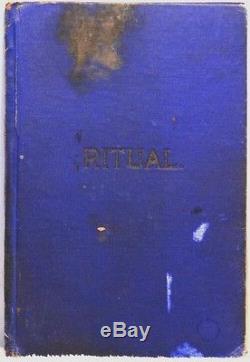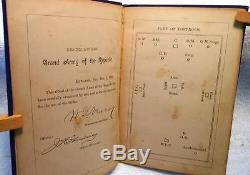1891 RITUAL GRAND ARMY OF THE REPUBLIC Civil War Union Veterans Soldiers History



Grand Army Of The Republic. Headquarters Grand Army Of The Republic, Rutland, Vermont. There are some small marks/stains and some edgewear on the cover and spine.
There is a very small number and letter on the top corner of the front flyleaf. The pages have tanned over time. There is foxing (faint age stains) on many pages. A few pages have a small crease on a corner. Otherwise this very rare book is in acceptable condition!
You probably won't find another copy of this 1891 book anywhere. This book has information regarding the conduct of the Grand Army of the Republic's meetings and some ceremonies. Plan Of PostRoom (a diagram). A History of the Grand Army of the Republic. After the end of American Civil War, organizations were formed for veterans to network and maintain connections with each other. Many of the veterans used their shared experiences as a basis for fellowship. Groups of men began joining together, first for camaraderie and later for political power. Emerging as most influential among the various organizations was the Grand Army of the Republic, founded on April 6, 1866, on the principles of "Fraternity, Charity and Loyalty, " in Decatur, Illinois, by Benjamin F. The GAR initially grew and prospered as a de facto political arm of the Republican Party during the heated political contests of the Reconstruction era. The commemoration of Union veterans, black and white, immediately became entwined with partisan politics. The GAR promoted voting rights for black veterans, as many veterans recognized their demonstrated patriotism. Black veterans, who enthusiastically embraced the message of equality, shunned black veterans' organizations in preference for racially inclusive groups.But when the Republican Party's commitment to reform in the South gradually decreased, the GAR's mission became illdefined and the organization floundered. The GAR almost disappeared in the early 1870s, and many divisions ceased to exist. In the 1880s, the organization revived under new leadership that provided a platform for renewed growth, by advocating federal pensions for veterans. As the organization revived, black veterans joined in significant numbers and organized local posts. The national organization, however, failed to press the case for pensions for black soldiers.
Most black troops never received any pension or remuneration for wounds incurred during their service. The GAR was organized into "Departments" at the state level and "Posts" at the community level, and militarystyle uniforms were worn by its members. There were posts in every state in the U. The pattern of establishing departments and local posts was later used by other veterans' organizations, such as the American Legion (WWI) and the Veterans of Foreign Wars (WWII). In 1868, CommanderinChief General John A. Logan established May 30 as Decoration Day, later known as Memorial Day. Numerous people and places claim this credit. In its first celebrations, people used this day to commemorate the dead of the Civil War by decorating their graves with flowers and flags. The GAR's political power grew during the latter part of the 19th century, and it helped elect several Republican United States presidents, beginning with Ulysses S.Grant and ending with William McKinley. Five members were elected president of the United States. For a time, candidates could not get nominated to the Republican ticket without the endorsement of the GAR voting bloc. With membership strictly limited to "veterans of the late unpleasantness, " the GAR encouraged the formation of Allied Orders to aid them in various works.
Numerous male organizations jousted for the backing of the GAR, and the political battles became quite severe until the GAR finally endorsed the Sons of Union Veterans of the Civil War as its heir. Although a male organization, the GAR admitted its sole woman member in 1897. Sarah Emma Edmonds served in the 2nd Michigan Infantry as a disguised man named Franklin Thompson from May 1861 until April 1863. In 1882, she collected affidavits from former comrades in an effort to petition for a veteran's pension which she received in July 1884.
Edmonds was only a member for a brief period as she died September 5,1898, however she was given a funeral with military honors when she was reburied in Houston in 1901. The GAR reached its largest enrollment in 1890, with 490,000 members. It held an annual "National Encampment" every year from 1866 to 1949. At that final encampment in Indianapolis, Indiana, the few surviving members voted to retain the existing officers in place until the organization's dissolution; Theodore Penland of Oregon, the GAR's Commander at the time, was therefore its last. In 1956, after the death of the last member, Albert Woolson, the GAR was formally dissolved.
This rare book would be nice for any Historian, Fraternal Civil War Group, Collector, or for anyone interested in History, the Civil War, or The Grand Army Of The Republic! Because of its rarity and despite its condition, it would be a nice Gift! If you have any questions, please feel free to contact me.
International Buyers - Please Note. Use the Store Search Box above or this Link to My Store. Dixie Cat's Books And Stuff. IF YOU ARE NOT RECEIVING EMAILS FROM US.
The item "1891 RITUAL GRAND ARMY OF THE REPUBLIC Civil War Union Veterans Soldiers History" is in sale since Tuesday, October 16, 2012. This item is in the category "Books\Antiquarian & Collectible". The seller is "dixiecat3313" and is located in Miami, Florida. This item can be shipped worldwide.- Binding: Hardcover
- Subject: Military & War
- Topic: Civil War (1861-65)
- Year Printed: 1891
- Special Attributes: Date Published ~ January 1, 1891
- Origin: American
- Original/Facsimile: Original
- Language: English

